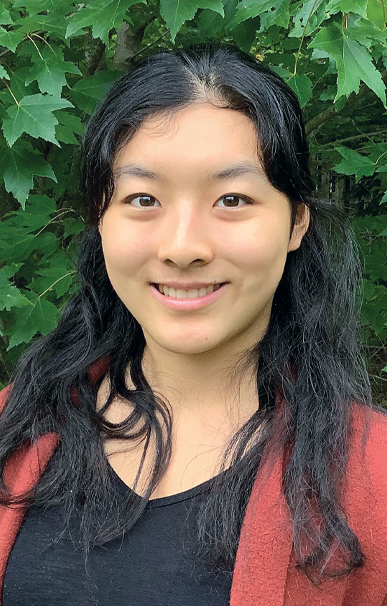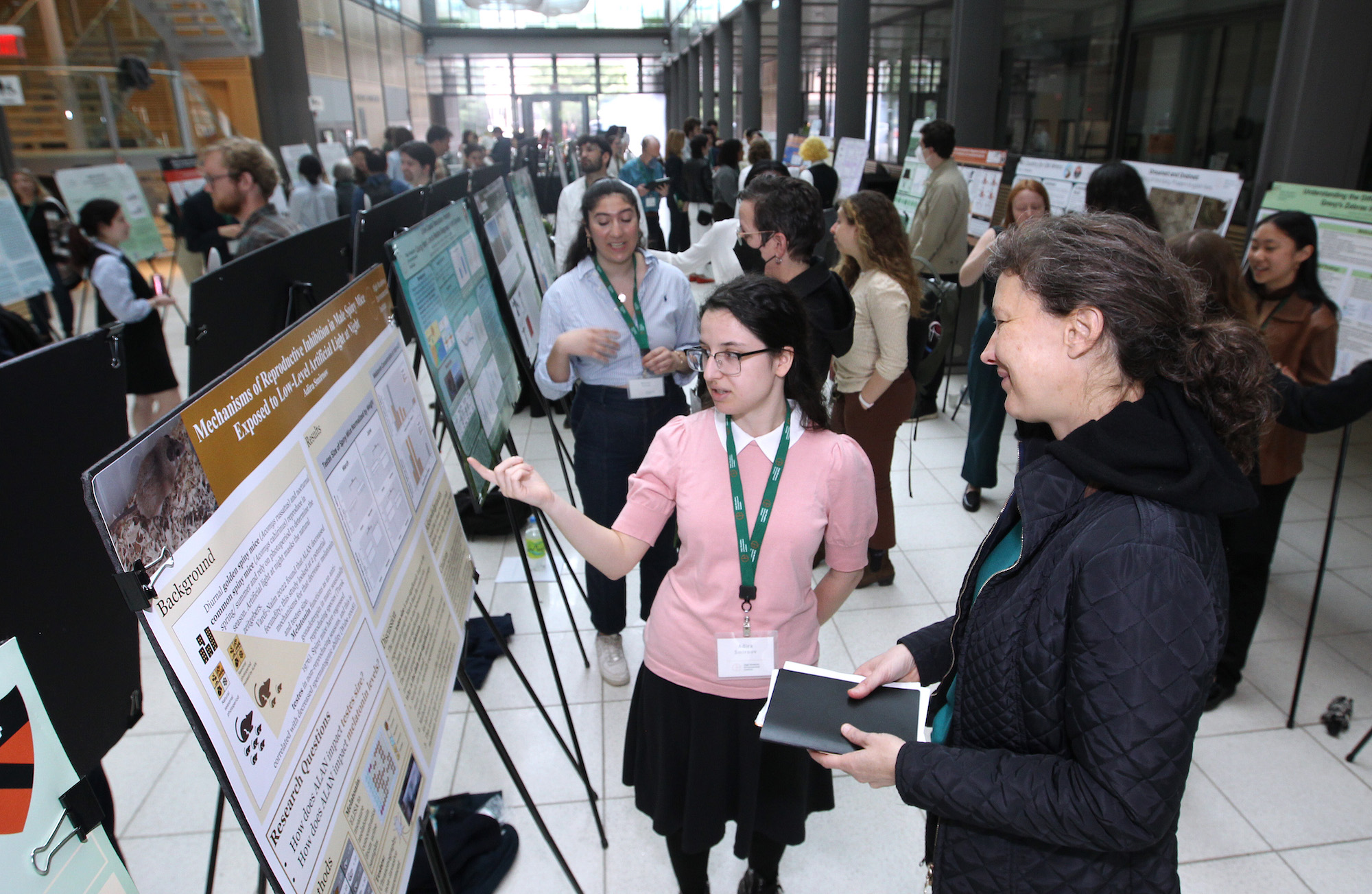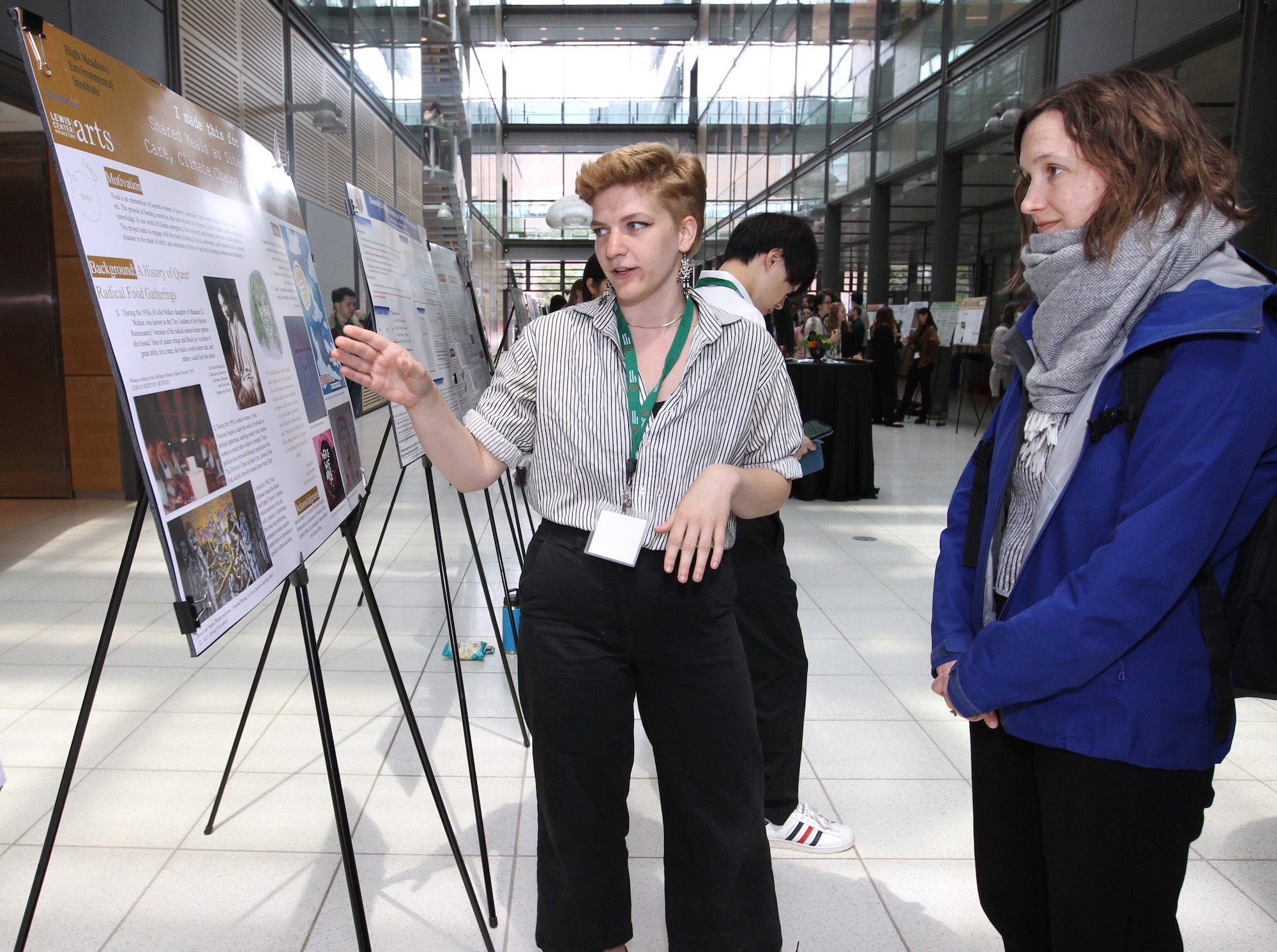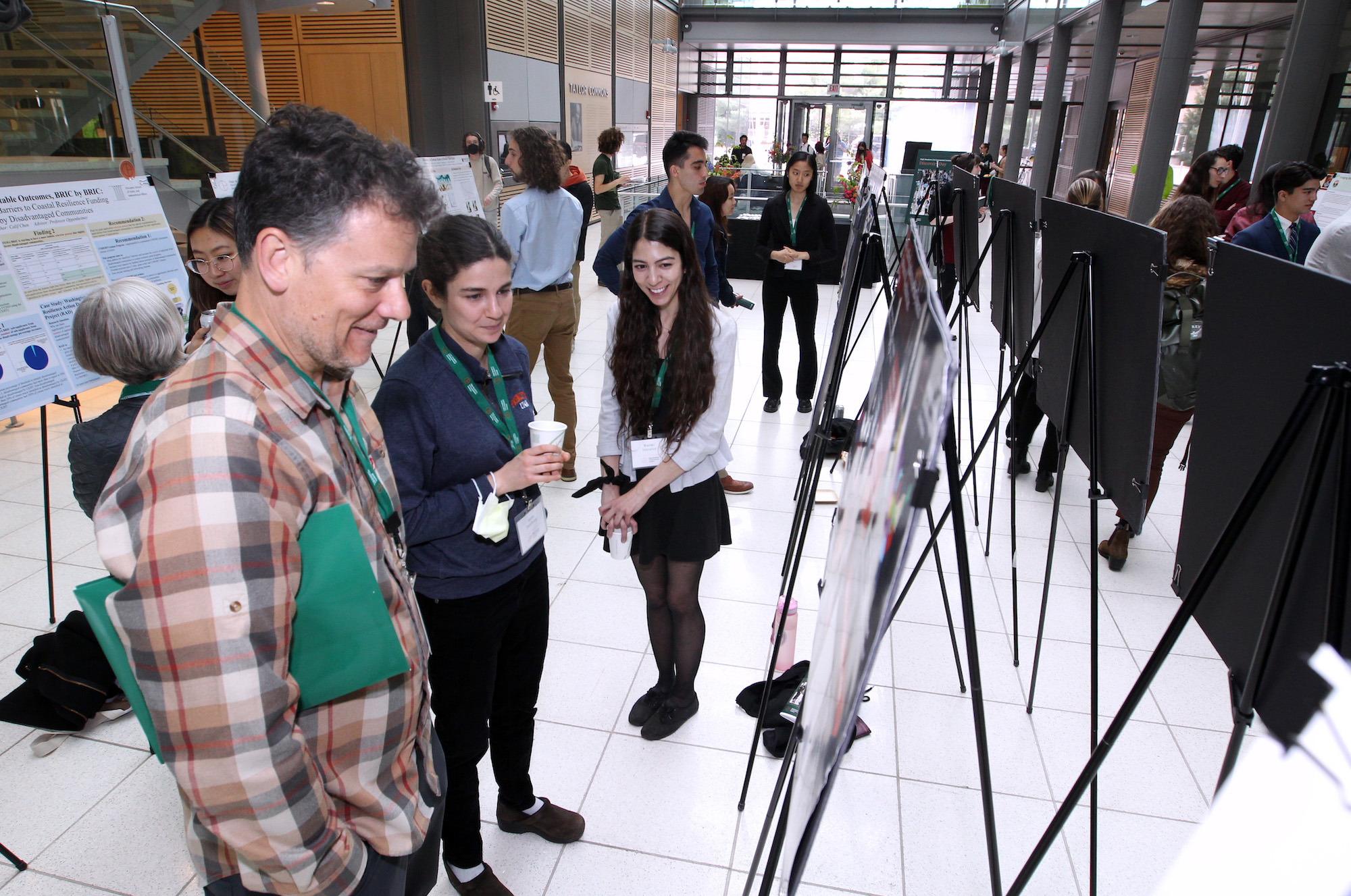HMEI Discovery Day Showcases Student Research on Environmental Topics
On May 3, the High Meadows Environmental Institute held its tenth annual Discovery Day event showcasing multidisciplinary student research on environmental topics. Held annually since 2012, this year’s poster show featured work by more than 100 students representing 27 academic disciplines and mentored by 59 faculty advisers.
As well as celebrating students’ achievements, Discovery Day provides an opportunity for students to display and discuss their research methodologies and results, to exchange perspectives, and to propose solutions to the world’s most pressing environmental challenges.
For this year’s show, student posters were categorized into seven focal themes: Biodiversity and Conservation, Climate and Environmental Science, Environmental Policy and Society, Water and the Environment, Urban Planning and Sustainable Communities, New Energy Future, and Health and Disease.
Student research projects examined a diverse range of topics such as the intersection of environmental justice and reproductive rights, the effects of air conditioning on RSV transmission, and methods for upcycling plastic waste. Other projects investigated bottlenecks in green hydrogen development, the effects of vegetation on Carolina Wren abundance, and determinants of human- biting preference in mosquitoes.
The photographs and profiles below provide snapshots of student research featured at Discovery Day 2023 and the students who participated. A complete listing of participants and projects is available in the event program.


Adviser: Reed Maxwell, Professor of Civil and Environmental Engineering and the High Meadows Environmental Institute, the William and Edna Macaleer Professor of Engineering and Applied Science, and Director of the Integrated GroundWater Modeling Center.
“Using Field-Informed Hydrologic Modeling to Understand Species-Specific Plant Water Stress under Differing Climate Scenarios”
For her senior thesis, Ashley Cao investigated the potential impact of climate change on plant communities in the Upper Colorado River Basin. “I wanted to know how changes in climate — specifically temperature, rainfall, and snowpack — might affect the vegetative composition of these subalpine meadows,” Cao said. Over the summer with support from HMEI, Cao conducted an informal survey of plants in the region, collecting data on native and invasive wildflowers and shrubs. She also collected a range of meteorological measurements, including precipitation, temperature, relative humidity, and soil moisture. Cao used these field data to build a model of the current vegetative cover in the region. Next, she manipulated different atmospheric variables within her model to simulate a range of climate change scenarios. “I tweaked the model in different ways, so for example I could increase the temperature a little bit, or change the amount of precipitation, or start the year with more or less snow to see how those changes impacted different plants.” Ashley found that, across all scenarios, invasive wildflowers outcompeted native wildflowers, invasive shrubs outcompeted native shrubs, and overall, shrubs did better than wildflowers. “This suggests that, in the event of these climate change scenarios, we might expect to see shrubs overtake native wildflowers in this region.” This could have cascading effects on insect pollinators in the region, and could also impact the local community, which currently generates more than $2 million annually from wildflower tourism.


Adviser: Miklos Racz, Assistant Professor of Operations Research and Financial Engineering
“Equity, Mobility, and Sustainability: Analyzing Geographic and Demographic Disparities in Urban Bikeability”
Senior Karena Yan compared the equity of “bikeability” for three US cities — San Francisco, Philadelphia, and Detroit. “Cities account for around 70% of global emissions, and a third of city emissions are from the transportation sector, so active forms of transportation that are low carbon like cycling can actually reduce global emissions by a lot,” Yan said. “However, a lot of current efforts to improve bike infrastructure have disproportionately served privileged populations — mostly white and wealthy neighborhoods—and previous bikeability measures have focused on adult, able-bodied men, whereas more vulnerable cyclists like women, people with disabilities, youth and seniors often aren’t able to use the same types of routes.” To compare bikeability between the cities and between regions within each city, Yan created networks based on the distance and discomfort associated with biking along their roads. Then, she looked at the relationship between these two factors: if cyclists must take circuitous routes in order to avoid riding on dangerous or uncomfortable roads, then that particular route has low “bikeability”. Yan then overlaid this bikeability map with demographic and socioeconomic data for the different neighborhoods, such as median income, the percentage of the population that is white, and vehicle ownership rate. She found that San Francisco was the most bikeable city overall, but it had the most disparity in bikeability between wealthy and impoverished neighborhoods, whereas bikeability in Philadelphia and Detroit was more even across different neighborhoods. However, when Yan incorporated accessibility into the analysis, San Francisco and Philadelphia were almost equally bikeable. “San Francisco underperforms relative to Philadelphia in maintaining equitable bikeability for cyclists with accessibility needs,” Yan said.


Adviser: Hanna Garth, Assistant Professor of Anthropology
“Growing as the Trees Grow: A Study of Human-Tree Interactions in South Central Los Angeles”
Annabel Dupont ‘23 explored food justice and interactions between humans and trees while volunteering with the non-profit Collective Care in South Central LA, an organization which harvests and redistributes food throughout the community. “South Central LA is generally considered a food desert,” Dupont said. “The neighborhood is predominantly Black and Brown with a lot of recent immigrants and also has a rich history of radical black activism in the area.” Dupont spent five weeks volunteering with Collective Care. Her time was spent on the farm, helping to harvest and redistribute fruit. She also interviewed the organization’s staff and community members to learn about grassroots efforts to combat obstacles to food justice such as lack of home ownership. “I was interested in looking at food systems that are local and small scale and centered around food justice to answer the question — what does it look like to have a food system that is really working to center human wellbeing as well as the wellbeing of the land and other species? I would say my main takeaway from this project would be to focus on ecological rhythms, unlike industrial agricultural systems, which are oriented around highest yield or highest profit margins.” Drawing upon her research and observations, Dupont stressed the importance of building long-term relationships within the community to share ecological and horticultural knowledge. “I came across a lot of people who are actually sharing materials or seeds, for instance, that are culturally significant to them and their families. I spoke to people who, when they immigrated to the United States, brought their seed varieties with them because they knew they wouldn’t be able to purchase them here.”


Adviser: Laure Resplandy, Assistant Professor of Geosciences and the High Meadows Environmental Institute
“Physical Controls of Coastal Hypoxia in the Indian Ocean Dipole”
For her senior thesis, Rachel Qing Pang explored the extent to which coastal hypoxia is impacted by the Indian Ocean Dipole, a phenomenon similar to the better known El Niño Southern oscillation “It’s an irregular oscillation of temperatures across the eastern and western basins of the Indian Ocean, and it reverses about every four years on average,” says Pang. “During one phase, the western side of the ocean is warmer and then, during the other phase, the eastern side is warmer.” Pang was motivated to examine this phenomenon to understand its implications for the people and animals that depend upon the Indian Ocean for their livelihoods. “Currently 30% of the world’s population resides along the coast of the Indian Ocean, and 75% (of that group) directly rely on their fisheries to sustain their livelihood,” says Pang. “Coastal hypoxia can limit the survival of a variety of animals across the ocean, for instance, fishes and crustaceans, and this has great implications for the fisheries and people who rely on those animals, as well as the rest of the food chain.” Using fluid dynamics equations coupled to real-world observations, Pang found evidence of spatial and temporal variation in how the Indian Ocean Dipole impact coastal hypoxia. “We found that the Indian Ocean Dipole affects different regions of the Indian Ocean across different phases and different extents. The positive phase of the Indian Ocean Dipole suppresses coastal hypoxia in the Arabian Sea but encourages it in the Bay of Bengal, and vice versa for the reverse phase,” says Pang. “From this information, if we can foresee which phase is coming, we can tell which regions will be more or less impacted.”


Adviser: John Higgins, Associate Professor of Geosciences
“A Minimally-Invasive, On-Site Identification Method for Lead-Lined Water Service Lines: A Case Study From Trenton, New Jersey”
Isabel Rodrigues ‘23 tested a new quick, efficient, and cost-effective method for identifying lead-lined water pipes. Lead was a commonly used material for water service lines, both by itself, and as an interior lining to galvanized steel pipes. Lead-lined pipes are more difficult to identify without disrupting water service. “We wanted to come up with a way to identify lead-lined service lines because they are relatively undocumented and really hard to identify in the field and on-site,” says Rodrigues. “We came up with a method that uses a portable x ray fluorescence analyzer, which is a commonly used instrument in mining and other materials identification, but it’s never really been used in this application.” Rodrigues used the device to test the insides and outsides of 650 pipes from Trenton and Hamilton Township, NJ. She found that the device was able to accurately detect a lead interior even when measurements were only taken on the external surface of the pipe. Rodrigues plans to continue this research over the summer. “We’re going to continue testing this method — we have another set of 600 samples that we’re going to test, and then we’re going to take it into the field this summer and test it in situ to see how it acts in a field setting, but so far it’s pretty promising.”


Adviser: Brian Herrera, Associate Professor of Theater in the Lewis Center for the Arts and Director of the Mellon Mays Undergraduate Fellowship Program
“I made this for you: Shared Meals as Sites of Memory, Care, Climate Change, and Resistance”
Senior Magdalena Poost explored the ritual of sharing food as a form of resistance in the midst of changing climates. “My main motivation was thinking about food as an intersection of all sorts of violences, and then instead choosing to recenter food as a site and a source of pleasure and hope in the midst of climate emergency,” says Poost. “I was inspired by the ritual of sharing a meal with people as a powerful site of community connection, and I wanted to explore and engage with this idea of taking care of ourselves and resting as a form of resistance against systems that are very violent, and which commodify the environment and our bodies.” To explore these ideas, Poost organized six pop-up meal and performance events around campus, collected oral histories of memories about meals and loss. She used her findings to create an immersive installation, wrote a play, and printed a zine. “As the climate and our ecologies continue to change, food and how we feed ourselves is going to become an increasingly fraught question,” says Poost. “I think this small, everyday site of how we feed ourselves, and especially how we feed ourselves in community, offers a place where we can think about how what is already here, and what is already sustaining us, may provide an idea of a radically joyful future, even in climate emergency.”














